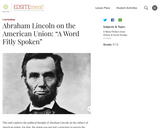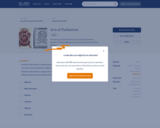
Have students bring articles on current events which either support or criticize the 1st Amendment
- Subject:
- Social Science
- Social Studies
- Material Type:
- Lesson
- Provider:
- School of Journalism
- Date Added:
- 09/07/2022


Have students bring articles on current events which either support or criticize the 1st Amendment

An interactive map that shows electoral college results for presidential elections. Also includes historical elections back to 1789, and various elections for Senate, House of Representatives, and governors. Students can also interactive with and manipulate the map to see how elections would have turned out with different results.

This lesson explores the challenges the United States faced as a result of the terrorist attacks on September 11, 2001, and examines the government's response through the lens of protection and civil liberties. Students will consider the long-term effects of the emergency measures, their consequences and constitutionality, and how they might inform the balance between security and liberty today.

This lesson explores the challenges the United States faced as a result of the terrorist attacks on September 11, 2001, and examines the governmentâ"s response through the lens of protection and civil liberties. Students will consider the balance between security and liberty in the United States.

The anniversaries of the terrorist attacks on the United States on September 11, 2001, and the signing of the Constitution on September 17, 1787, provide us an opportunity to reflect upon who we are as Americans, examine our most fundamental values and principles and affirm our commitment to them, and evaluate progress toward the realization of American ideals and propose actions that might narrow the gap between these ideals and reality. The following lessons are designed to accomplish these goals.

The anniversaries of the terrorist attacks on the United States on September 11, 2001, and the signing of the Constitution on September 17, 1787, provide us an opportunity to reflect upon who we are as Americans, examine our most fundamental values and principles and affirm our commitment to them, and evaluate progress toward the realization of American ideals and propose actions that might narrow the gap between these ideals and reality. These lessons are designed to accomplish these goals.

Students will explore the vice of ambition in a constitutional republic and civil society in this lesson on civic virtue. Students will examine the difference between self-serving ambition and noble ambition, and then explore the character and career of Aaron Burr. Burr engaged in various machinations to establish an empire in the West and was put on trial for treason. Students will analyze a historical narrative, discussion guide, and various activities to explore the effect of self-serving ambition in a constitutional republic and on civil society.

Use this lesson with the Mercy Otis Warren Narrative and the Judith Sargent Murray Primary Source "On the Equality of the Sexes" to allow students to discuss gender roles and expectations in the founding period.

Read information about the "Founding Fathers" of the United States of America, including George Washington, James Madison, Thomas Jefferson, John Adams, Benjamin Franklin, Alexander Hamilton, George Mason, Gouverneur Morris, Roger Sherman, James Wilson, and Edmund Randolph.

On September 17, 1787, the Constitutional Convention came to a close in the Assembly Room of Independence Hall in Philadelphia, Pennsylvania. There were seventy individuals chosen to attend the meetings with the initial purpose of amending the Articles of Confederation.

The "Great Writ" or habeas corpus has been an essential civil liberty guaranteed since Magna Carta. In listing powers denied to Congress, the Constitution notes that "The privilege of the writ of habeas corpus shall not be suspended, unless when in cases of rebellion or invasion the public safety may require it." In 1861, Abraham Lincoln invoked this power of Congress—which was not in session—to suspend habeas corpus in certain areas. The next year, as he believed the civil justice system was inadequate to deal with the rebellion, he expanded the suspension throughout the United States and established military tribunals to try citizens charged with disloyalty. In this lesson, students explore Lincolnâ"s suspension of habeas corpus and constitutional issues surrounding it.

Presidents Buchanan, Lincoln, and Johnson believed that the Constitution protected the institution of slavery. Lincoln came to the conclusion that, in order to preserve the Constitution and the Union it created, he must apply a new understanding of the principles on which the nation was built. The time had come to bring the nationâ"s policies in line with the of the Declaration of Independence that "…all men are created equal…" In this lesson, students will analyze Abraham Lincolnâ"s views on slavery and the Constitution as evidenced in the Emancipation Proclamation.

This lesson traces Lincoln's political life during a time of constitutional crisis. It examines Lincoln's ideas and decisions regarding slavery and the use of presidential power to preserve the Union.

By examining Lincoln's three most famous speeches the Gettysburg Address and the First and Second Inaugural Addresses in addition to a little known fragment on the Constitution, union, and liberty, students trace what these documents say regarding the significance of union to the prospects for American self-government.

In this lesson, students will learn about Abraham Lincolnâ"s Emancipation Proclamation. Students will specifically learn about how Lincolnâ"s actions conform to the idea of justice and how they can apply this idea into actions in their own lives.

This lesson is based on the Annenberg Classroom video âA Call to Act: Ledbetter v. Goodyear Tire and Rubber Co.,â which tells the law-changing story behind the Lilly Ledbetter Fair Pay Act of 2009. Students gain insight into law-making process, consider how statutory decisions made by the Supreme Court can prompt better laws, and learn about the rights and responsibilities they will have when they enter the workforce.
The estimated time for this lesson is four days.

Students should have a solid foundation of the regional differences in the former colonies, now states, as well as an understanding of the ratification of the Constitution. This Lesson is best used after students have read The Constitutional Convention and The Ratification Debate on the Constitution Narratives in Chapter 3. The James Madison and the Bill of Rights Narrative in Chapter 4 can be used as background for the Lesson or can be assigned as homework after the Lesson to reinforce main ideas.

Use this lesson as the foundation for the Stamp Act Resistance Narrative, The Boston Massacre Narrative, and The Boston Tea Party Narrative.

Constitutional amendments were ratified during and after the Civil War to protect the natural and civil rights of African Americans. Despite these legal protections, the condition of African Americans significantly worsened in the last few decades of the nineteenth century. In the late nineteenth century, the promise of emancipation and Reconstruction went largely unfulfilled and was even reversed in the lives of African Americans. Southern blacks suffered from horrific violence, political disfranchisement, economic discrimination, and legal segregation. Ironically, the new wave of racial discrimination that was introduced was part of an attempt to bring harmony between the races and order to American society.

In this lesson, students will study the life of Alexander Hamilton. Students will learn about his reasoning in supporting a single and powerful executive leader, his role at the Constitutional Convention, and the role he played in shaping the new United States government.